
The Benjamin Harrison School in Cayey is a school in the Puerto Rico public school system.

The Benjamin Harrison School in Cayey is a school in the Puerto Rico public school system.
Now named Benjamin Harrison Vocational School, it is located on PR-14, José de Diego Avenue in Cayey.
After the occupation of the United States in Puerto Rico and identifying illiteracy as one of the main problems in the island, the government developed a program for the construction of schools among other projects.
The Benjamin Harrison School was finished by October 23, 1902 with a total cost of $8,600.00 invested in its construction. [1]

The original design of the school was a two-floor building in a rectangular shape with a gabled roof, similar to Washington's Graduate School from Guayama.
It had four classrooms, a basement, and an attic. The attic was built in order to get the best of the space beneath the gabled roof. In the front, it had two stairways providing an enormous balcony connecting two upstairs classrooms. The first floor had a carcade (corridor) or a hallway that connected the front yard through four stairways. The school had an enormous backyard and its sanitary facilities were a latrine.
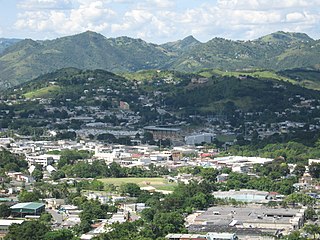
Cayey, officially Cayey de Muesas, is a mountain town and municipality in central Puerto Rico located on the Sierra de Cayey within the Central Mountain range, north of Salinas and Guayama; south of Cidra and Caguas; east of Aibonito and Salinas; and west of San Lorenzo. Cayey is spread over 21 barrios plus Cayey Pueblo. It is part of the San Juan-Caguas-Guaynabo Metropolitan Statistical Area.

The University of Puerto Rico is the main public university system in the U.S. Commonwealth of Puerto Rico. It is a government-owned corporation with 11 campuses and approximately 44,200 students and approximately 4,450 faculty members. UPR has the largest and most diverse academic offerings in the commonwealth, with 472 academic programs of which 32 lead to a doctorate.
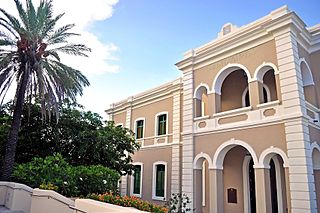
The Puerto Rico Conservatory of Music is a public conservatory in San Juan, Puerto Rico. It has hosted a number of international musicians as students as well as faculty, and has a longstanding relationship with the classical music movement in Puerto Rico, including the annual Casals Festival and the Puerto Rico Symphony Orchestra (PRSO).

Guayama, officially the Autonomous Municipality of Guayama, is a city and municipality on the Caribbean coast of Puerto Rico. As of the 2020 U.S. Census, the city had a population of 36,614. It is the center of the Guayama metropolitan area with a population of 68,442 in 2020.

The American Foursquare or American Four Square is an American house style popular from the mid-1890s to the late 1930s. A reaction to the ornate and mass-produced elements of the Victorian and other Revival styles popular throughout the last half of the 19th century, the American Foursquare was plain, often incorporating handcrafted "honest" woodwork. This style incorporates elements of the Prairie School and the Craftsman styles. It is also sometimes called Transitional Period.

The Catedral de Nuestra Señora de Guadalupe is the cathedral for the Roman Catholic Diocese of Ponce located in downtown Ponce, Puerto Rico. The cathedral lies in the middle of Ponce's town square, known as Plaza Las Delicias, located at the center of the Ponce Historic Zone. For its historic significance, the cathedral was listed on the National Register of Historic Places in 1984. It is the seat of the Bishop of Ponce, currently Rubén González Medina.

Chana School is a Registered Historic Place in Ogle County, Illinois, in the county seat of Oregon, Illinois. One of six Oregon sites listed on the Register, the school is an oddly shaped, two-room schoolhouse which has been moved from its original location. Chana School joined the Register in 2005 as an education museum.

Creole architecture in the United States is present in buildings in Louisiana and elsewhere in the South, and also in the U.S. associated territories of Puerto Rico and the U.S. Virgin Islands. One interesting variant is Ponce Creole style.
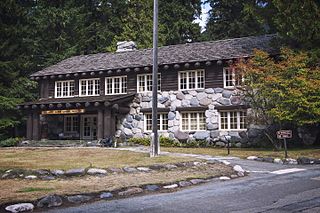
The Longmire Buildings in Mount Rainier National Park comprise the park's former administrative headquarters, and are among the most prominent examples of the National Park Service Rustic style in the national park system. They comprise the Longmire Community Building of 1927, the Administration Building of 1928, and the Longmire Service Station of 1929. Together, these structures were designated National Historic Landmarks on May 28, 1987. The administration and community buildings were designed by National Park Service staff under the direction of Thomas Chalmers Vint.

Benjamin Church House is a Colonial Revival house at 1014 Hope Street in Bristol, Rhode Island, U.S.A. It opened in 1909 as the "Benjamin Church Home for Aged Men" as stipulated by Benjamin Church's will. Beginning in 1934, during the Great Depression, it admitted women. The house was closed in 1968 and became a National Register of Historic Places listing in 1971. The non-profit Benjamin Church Senior Center was incorporated in June 1972 and opened on September 1, 1972. It continues to operate as a senior center.

The Ballajá Barracks is a historic building and former military barracks located in the Ballajá section of Old San Juan, in the city of San Juan, Puerto Rico. It is located close to El Morro and its esplanade, between the Morovis, Beneficiencia and Norzagaray streets. It was built from 1854 to 1864 to house Spanish and Puerto Rican regiments. The Ballajá Barracks were the last large-scale construction project made by the Spanish Crown in the Americas.
The Carretera Central is a historic north–south central highway in Puerto Rico, linking the cities of San Juan and Ponce by way of Río Piedras, Caguas, Cayey, Aibonito, Coamo, and Juana Díaz. It crosses the Cordillera Central. Plans for the road started in the first half of the 19th century, and the road was fully completed in 1898. At the time the United States took possession of Puerto Rico in 1898, the Americans called it "the finest road in the Western Hemisphere."

The U.S. Customs House, located at Bonaire and Aduana streets in barrio La Playa, Ponce, Puerto Rico, is the oldest customs house in Puerto Rico, and the only one of its type under the U.S. flag. As of 10 February 1988, the building was owned by the U.S. Customs Service, Washington, D.C. The building is listed on the U.S. National Register of Historic Places as "U.S. Custom House". It was listed on 10 February 1988.
The University High School, commonly referred to by its initials "UHS", in San Juan, Puerto Rico is a college preparatory laboratory high school operated by the Faculty of Education of the University of Puerto Rico. Located on the University of Puerto Rico, Río Piedras Campus, it provides education to approximately 514 students from 7th to 12th grade.
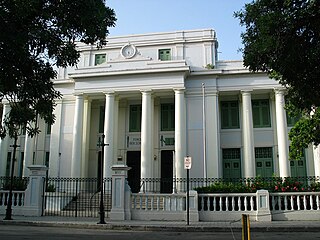
The Ponce High School is public educational institution in Ponce, Puerto Rico, offering grades nine through twelve. The school's main building is a historic structure located on Cristina Street, in the Ponce Historic Zone. From its beginning the school has secured a unique place in Puerto Rico's educational history. Of over 3,000 schools erected in Puerto Rico in the first quarter of the twentieth century, Ponce High was the largest, "at a time enrolling more students than all the other Puerto Rico high schools combined", and for many years enrolling more students than any other high school in Puerto Rico. The cost of the building in 1915 dollars was $150,000 USD. The building was listed on the U.S. National Register of Historic Places on 4 August 1987. The school has the only diamond-level DECA chapter in Puerto Rico. The Ponce High School building is "among the most important public buildings ever built in Puerto Rico." The school is the oldest continuously-operating high school in Puerto Rico.

The U.S. Customs House,, located at Calle Union, Fajardo, Puerto Rico, was constructed in 1930. The poured-concrete building is significant architecturally and historically for the role it played in the first, transitional phase of the American customs service in Puerto Rico, from 1898 through 1931. This period is bracketed on one end by the cession, on December 10, 1898, of the island of Puerto Rico to the United States by Spain as a condition of the Treaty of Paris ending the Spanish–American War, and on the other by the completion in 1931 of the major building and rehabilitation program undertaken by the U.S. Customs Service following World War I.
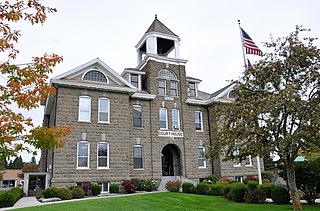
The Wallowa County Courthouse is the seat of government for Wallowa County in northeastern Oregon. The courthouse is located in Enterprise, Oregon. It was built in 1909–1910 using locally quarried stone. It is a massive High Victorian structure built of local Bowlby stone. The courthouse was listed on National Register of Historic Places in 2000. Today, the courthouse still houses Wallowa County government offices.

Bennington No. 4, also known as the Bennington School, is a one-room schoolhouse near Waterloo, Iowa. Built in 1911, it served four sections which provided as many as thirty or more students for first through eighth grades. Students in higher grades attended Waterloo East High School. The school served the predominantly German-American community until 1955 when it was closed. While it was open, the school also served as a community center. In 1958 the vacant building was sold to the local Sage family, whose members had attended and taught at the school. Restoration work took place through the 1990s.
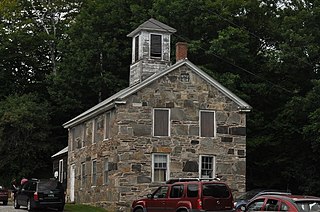
The South Reading Schoolhouse is a historic school building at Tyson and Bartley Roads in Reading, Vermont. Built in 1834, it is a distinctive example of the regional "snecked masonry" style, and the oldest known structure of the style to survive. It was used as a school until 1970, and was listed on the National Register of Historic Places in 1983.
Gloria E. Baquero Lleras is a Puerto Rican educator and university administrator. She was the Secretary of Education of Puerto Rico from January to June 2005. In 2011, Baquero Lleras was appointed president of National University College.